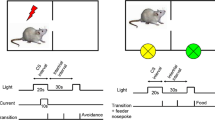Abstract
The intensity of a buzzer conditioned stimulus (CS) was manipulated during shock-escape conditioning and extinction of albino rats in a straight runway, using a guillotine-door procedure. After 20 acquisition trials, the rats were placed on extinction, but half were given regular extinction trials and half were subjected to shock punishment in the goal box at the termination of each run. The CS conditions of no buzzer, 71-dB buzzer, and 83- dB buzzer had no significant effects during acquisition, and they did not differentiate punished groups during extinction. Nevertheless, the higher intensity buzzer produced faster running on the part of nonpunished animals during extinction than did the no buzzer condition. In contrast to certain theoretical positions, punishment facilitated running under all CS conditions. The results were interpreted as a function of the differential presence of conditioned aversive stimulation with reference to the rat’s presence in different parts of the apparatus.
Similar content being viewed by others
References
BABB, H., & HOM, H. L., JR. 1971. Self-punitive responding by goal-shocked rats. Journal of Comparative and Physiological Psychology, 77, 482–488.
BINDRA, D. 1976. A theory of intelligent behavior. New York: John Wiley & Sons.
BROWN, J. S. 1969. Factors affecting self-punitive locomotor behavior. In B. A. Campbell & R. M. Church (Eds.), Punishment and aversive behavior. New York: Appleton-Century-Crofts.
CHURCH, R. M. 1963. The varied effects of punishment on behavior. Psychological Review, 70, 369–402.
DELUDE, L. A. 1969. The vicious circle phenomenon: A result of measurement artifact. Journal of Comparative and Physiological Psychology, 69, 246–252.
DELUDE, L. A. 1973. Factors affecting the strength of the vicious circle phenomenon. The Psychological Record, 23, 467–476.
EATON, N. K., & CROWELL, C. R. 1977. Two-way self-punitive locomotor behavior. Bulletin of the Psychonomic Society, 9, 73–76.
HOM, H. L., JR., & BABB, H. 1975. Self-punitive responding in rats with goal shock and color change. Animal Learning & Bpehavior, 3, 152–156.
KARPICKE, J., CRISTOPH, G., PETERSON, G., & HEARST, E. 1977. Signal location and positive versus negative conditioned suppression in the rat. Journal of Experimental Psych ology: A nimal Behavior Processes, 3, 105–118.
MATTHEWS, M. D., & BABB, H. 1978. Effects of the percentage of goal-punished extinction trials on self-punitive behavior. Bulletin of the Psychonomic Society, 12, 64–66.
MILLER, N. E. 1948. Studies of fear as an acquirable drive: I. Fear as motivation and fear- reduction as reinforcement in the learning of new responses. Journal of Experimental Psychology, 38, 89–101.
RENNER, K. E., & TINSLEY, J. B. 1976. Self-punitive behavior. In G. H. Bower (Ed.), The psychology of learning and motivation (Vol. 10). New York: Academic Press.
Author information
Authors and Affiliations
Rights and permissions
About this article
Cite this article
Babb, H. Facilitation by Goal Punishment After Escape Conditioning: CS Intensity Effects. Psychol Rec 30, 229–236 (1980). https://doi.org/10.1007/BF03394673
Published:
Issue Date:
DOI: https://doi.org/10.1007/BF03394673




